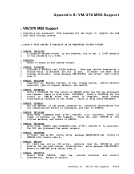The error recovery routine keeps track of the number of retries in
the IOBRCNT field of theIOBLOK. This count determines if a retry limit has been exceeded for a particular error. On initial entry from DMKICS for an error condition, the count is zero. Each time a retry is
attempted, the count is increasedby one.
TheERP preserves the original error CSW and sense information by placing a pointer to the original IOERBLOK in the RDEVBLOK. Additional IOERBLOKs, which are received from DMKIOS on failing restart attempts,
are discarded. The originalIOERBLOK is thus preserved for recording
purposes.
If after a specified number of retries,DMKDAS fails to correct the
error, the operator mayormay not be notified of the error. Control is
returned toDMKIOS.DMKIOS is notified of the permanent error by posting
theIOBLOK (IOBST1T=IOBFATAL). The error is recorded via DMKIOS by D~KIOERR~ if DMKDAS and DMKIOE determine that the error warrants
recording.
If the error is correctedby a restart, the temporary or transient
error is not recorded. Control is returned toDMKIOS with the error flag
off.
Before returning control toDMKIOS on either a permanent error or a
successful recovery, theERP frees all auxiliary storage gotten for
recoveryCCWs, buffers, and IOERBLOKs, and updates the statistical
counters for 2314 and 2319 devices.
TheDMKIOS interface with the ERP uses the IOBSTAT and IOBFLAG fields
of theIOBLOK to determine the action required when the ERP returns to DMKIOS. When retry is to be attempted, the ERP turns on the restart bit of
the IOBFLAG field. TheERP bit of the IOBFL1G field is also turned on to
indicate toDMKIOS that the ERP wants control back when the task has
finished. This enables theERP to receive control even if the retry was
successful and allows the freeing of all storage gotten forCCWs and temporary buffers. The IOBRCAW is set to the recovery CCW string
address.
In handling anintervention-required situation~ the ERP sends a
message to the operator and then waits for the device end to arrive.
This is accomplishedby a return to DMKIOS with the ERP bit in the
IOBFLAG field set on and theIOBSTRT bit in the IOBFLAG field set off. When the device end interruption arrives, the original channel program
which was interrupted is then started.
TheERP flags of the IOERBLOK are also used to indicate when special
recovery is being attempted. For example, a READHOME ADDRESS command when a no record found error occurs.
The other two indicators are self-explanatory and are explained in
Figure 22.CP Introduction 1-165
the IOBRCNT field of the
attempted, the count is increased
The
are discarded. The original
purposes.
If after a specified number of retries,
error, the operator mayor
returned to
the
recording.
If the error is corrected
error is not recorded. Control is returned to
off.
Before returning control to
successful recovery, the
recovery
counters for 2314 and 2319 devices.
The
of the
the IOBFLAG field. The
indicate to
finished. This enables the
successful and allows the freeing of all storage gotten for
address.
In handling an
message to the operator and then waits for the device end to arrive.
This is accomplished
IOBFLAG field set on and the
which was interrupted is then started.
The
recovery is being attempted. For example, a READ
The other two indicators are self-explanatory and are explained in
Figure 22.








































































































































































































































































































































































































































































